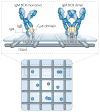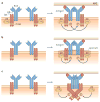The tipping points in the initiation of B cell signalling: how small changes make big differences
- PMID: 20935671
- PMCID: PMC3406597
- DOI: 10.1038/nri2853
The tipping points in the initiation of B cell signalling: how small changes make big differences
Abstract
B cells are selected by the binding of antigen to clonally distributed B cell receptors (BCRs), triggering signalling cascades that result in B cell activation. With the recent application of high-resolution live-cell imaging, we are gaining an understanding of the events that initiate BCR signalling within seconds of its engagement with antigen. These observations are providing a molecular explanation for fundamental aspects of B cell responses, including antigen affinity discrimination and the value of class switching, as well as insights into the underlying causes of B cell tumorigenesis. Advances in our understanding of the earliest molecular events that follow antigen binding to the BCR may provide a general framework for the initiation of signalling in the adaptive immune system.
Conflict of interest statement
The authors declare no competing financial interests.
Figures




References
-
- McHeyzer-Williams LJ, McHeyzer-Williams MG. Antigen-specific memory B cell development. Annu Rev Immunol. 2005;23:487–513. - PubMed
-
- Tarlinton D. B-cell memory: are subsets necessary? Nature Rev Immunol. 2006;6:785–790. - PubMed
-
- Rajewsky K. Clonal selection and learning in the antibody system. Nature. 1996;381:751–758. - PubMed
-
- Reth M, Wienands J. Initiation and processing of signals from the B cell antigen receptor. Annu Rev Immunol. 1997;15:453–479. - PubMed
-
- Tolar P, Sohn HW, Pierce SK. The initiation of antigen-induced B cell antigen receptor signaling viewed in living cells by fluorescence resonance energy transfer. Nature Immunol. 2005;6:1168–1176. - PubMed
Publication types
MeSH terms
Substances
Grants and funding
LinkOut - more resources
Full Text Sources
Other Literature Sources

